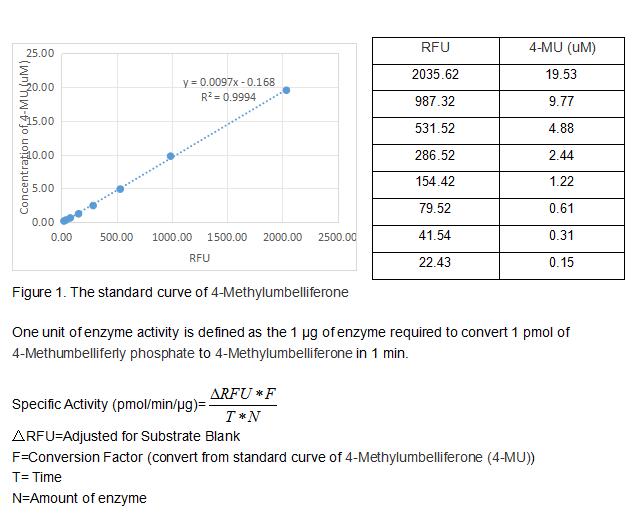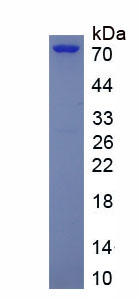Active Alkaline Phosphatase, Tissue-nonspecific (ALPL) 

BALP; BSAP; HOPS; AP-TNAP; TNSALP; Bone Alkaline Phosphatase; Alkaline Phosphatase,Tissue-Nonspecific Isozyme; Alkaline Phosphatase, Liver/Bone/Kidney
- UOM
- FOB US$ 302.00 US$ 756.00 US$ 1,512.00 US$ 4,536.00 US$ 11,340.00
- Quantity
Overview
Properties
- Product No.APB091Hu61
- Organism SpeciesHomo sapiens (Human) Same name, Different species.
- ApplicationsCell culture; Activity Assays.
Research use only - DownloadInstruction Manual
- CategoryEnzyme & KinaseMetabolic pathwayHepatologyBone metabolism
- Buffer FormulationPBS, pH7.4, containing 5% Trehalose.
- Traits Freeze-dried powder, Purity > 90%
- Isoelectric Point6.7
Sign into your account
Share a new citation as an author
Upload your experimental result
Review

Contact us
Please fill in the blank.
Activity test

Four distinct genes encode alkaline phosphatases (APs) in humans. The ALPL gene encodes the liver/bone/kidney isozyme, also known as the tissue nonspecific AP (TNAP). In comparison, ALPI, ALPP and ALPPL2 encode intestinal, placental and placental-like or germ cell APs, respectively. The serum levels of human APs are useful tumor markers. There are many mutations in the ALPL gene, leading to different forms of hypophosphatasia, characterized by poorly mineralized cartilage and bones. The native ALPL is a glycosylated homodimer attached to the membrane through a GPI-anchor. The activity assay of recombinant human ALPL was measured by its ability to cleave a peptide substrate, 4-Methumbelliferly phosphate. The reaction was performed in 50 mM Tris, 1 mM MgCl2, pH 9.0 ( assay buffer), ainitiated by addition 50 μL of 0.625 ug/ml ALPL (diluted by assay buffer) to 50 µL of 50 uM substrate. Read at excitation and emission wavelengths of 365 nm and 445 nm (top read), respectively, in kinetic mode for 5 minutes. The specific activity of recombinant human ALPL is >11000 pmol/min/µg.
Usage
Reconstitute in 10mM PBS (pH7.4) to a concentration of 0.1-1.0 mg/mL. Do not vortex.
Storage
Avoid repeated freeze/thaw cycles. Store at 2-8°C for one month. Aliquot and store at -80°C for 12 months.
Stability
The thermal stability is described by the loss rate. The loss rate was determined by accelerated thermal degradation test, that is, incubate the protein at 37°C for 48h, and no obvious degradation and precipitation were observed. The loss rate is less than 5% within the expiration date under appropriate storage condition.
Increment services
-
 BCA Protein Quantification Kit
BCA Protein Quantification Kit
-
 Molecular Mass Marker for Protein
Molecular Mass Marker for Protein
-
 Monoclonal Antibody Customized Service
Monoclonal Antibody Customized Service
-
 Polyclonal Antibody Customized Service
Polyclonal Antibody Customized Service
-
 Protein Activity Test Experiment Service
Protein Activity Test Experiment Service
-
 Electrophoretic Mobility Shift Assay (EMSA) Experiment Service
Electrophoretic Mobility Shift Assay (EMSA) Experiment Service
-
 Buffer
Buffer
-
 Lentivirus Packaging Experiment Service
Lentivirus Packaging Experiment Service
-
 Adenovirus Packaging Experiment Service
Adenovirus Packaging Experiment Service
-
 Real Time PCR Experimental Service
Real Time PCR Experimental Service
-
 Spike RBD Protein (S-RBD)
Spike RBD Protein (S-RBD)
-
 Protein G
Protein G
-
 Protein A
Protein A
Citations
- Osteopenic bone cell response to strontium-substituted hydroxyapatiteSpringerLink: n8233337w171v451
- Dextromethorphan inhibits osteoclast differentiation by suppressing RANKL-induced nuclear factor-κB activationPubMed: 23400250
- Chronic exposure to low concentrations of strontium 90 affects bone physiology but not the hematopoietic system in miceWiley: Source
- The antidepressant bupropion exerts alleviating properties in an ovariectomized osteoporotic rat modelPubmed:25544359
- Enhanced differentiation of osteoblastic cells on novel chitosan/β-1, 3-glucan/bioceramic scaffolds for bone tissue regenerationPubmed:25586067
- Effect of Mirtazapine on Rat Bone Tissue after OrchidectomyPubMed: 25871861
- New method for the fabrication of highly osteoconductive β-1,3-glucan/HA scaffold for bone tissue engineering: Structural, mechanical, and biological characterization.Pubmed:27239050
- MiR-142-5p promotes bone repair by maintaining osteoblast activityPubmed:27085967
- New method for the fabrication of highly osteoconductive β‐1, 3‐glucan/HA scaffold for bone tissue engineering: Structural, mechanical, and biological …doi:10.1002
- MiR‑142‑5p promotes bone repair by maintaining osteoblast activitypubmed:27085967
- Hydrolysis of Extracellular Pyrophosphate increases in post-hemodialysis plasmaPubmed:30038263
- Suppression Effect of Astaxanthin on Osteoclast Formation In Vitro and Bone Loss In VivoPubmed:29562730
- Effects of Amlodipine on Bone Metabolism in Orchidectomised Spontaneously Hypertensive RatsPubmed:29898457
- Combination therapy with BMP‑2 and psoralen enhances fracture healing in ovariectomized mice10.3892:etm.2018.6353
- Long non-coding RNA SNHG7 promotes the fracture repair through negative modulation of miR-9
- The effect of low temperature atmospheric nitrogen plasma on MC3T3-E1 preosteoblast proliferation and differentiation in vitro
- Bovine Hydroxyapatite-Based Bone Scaffold with Gentamicin Accelerates Vascularization and Remodeling of Bone Defect34104195







